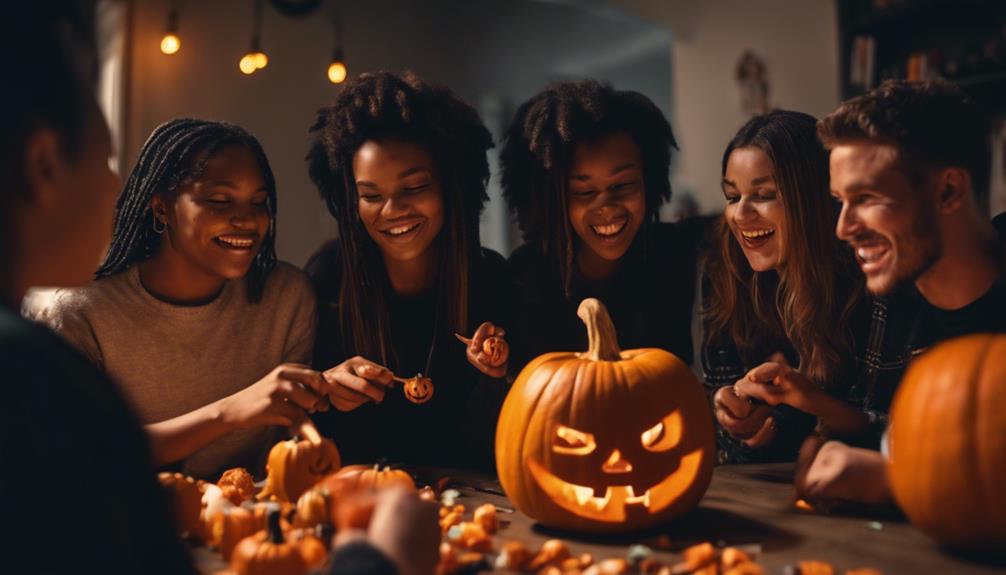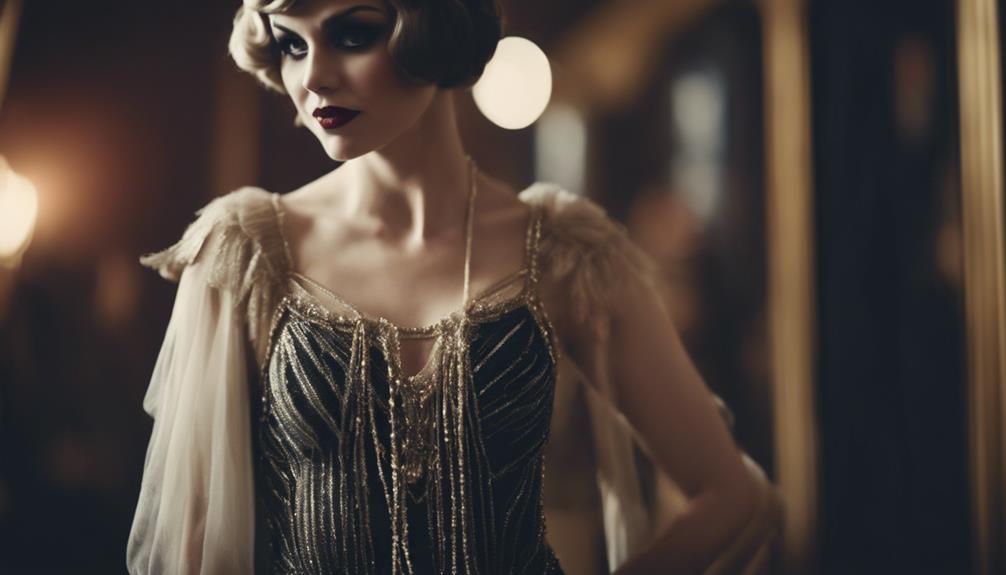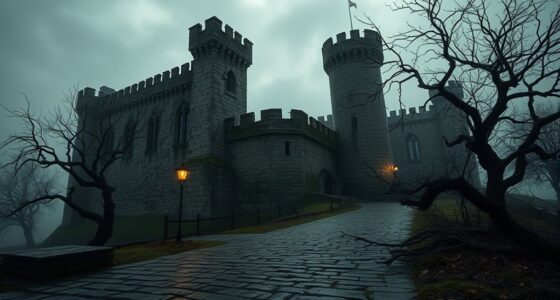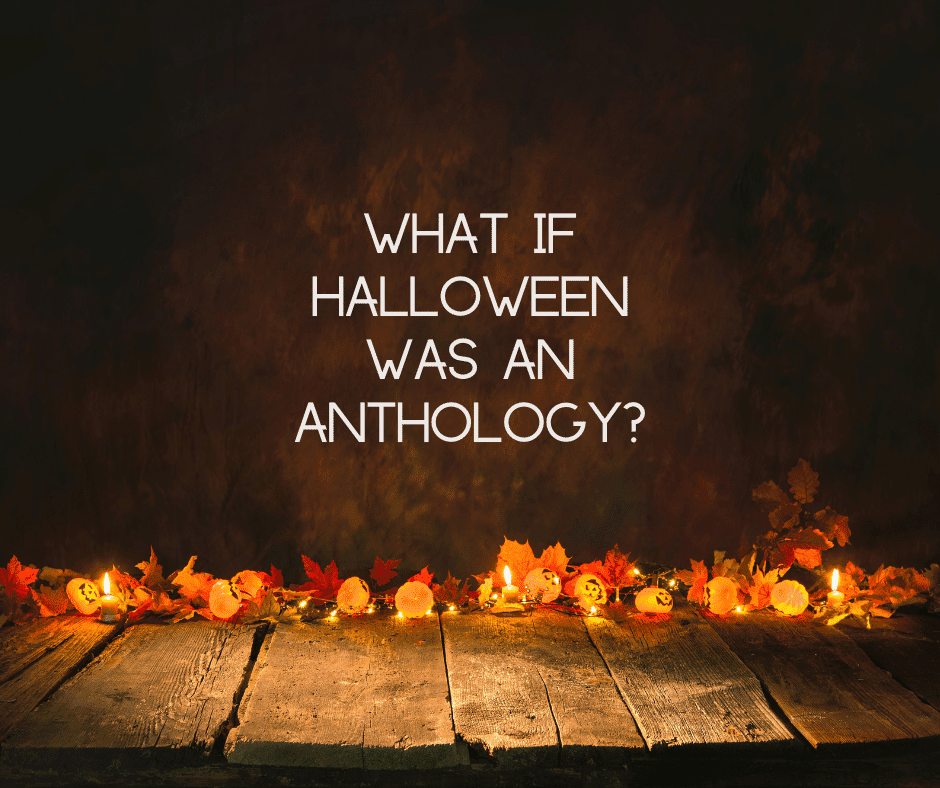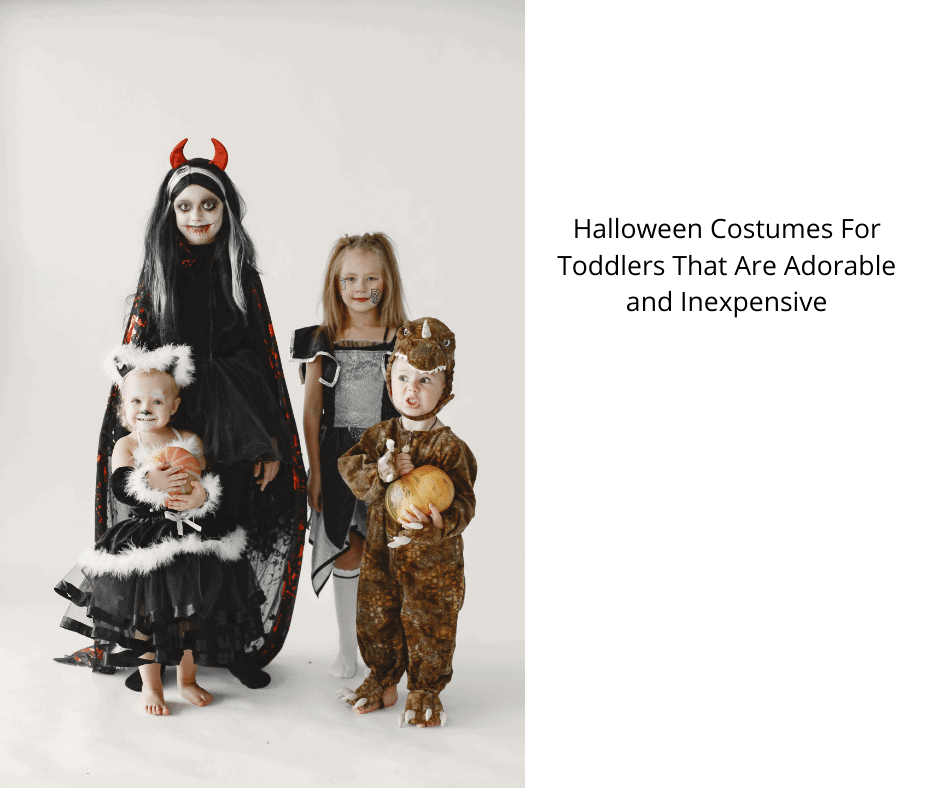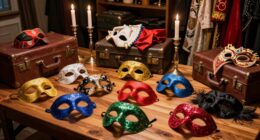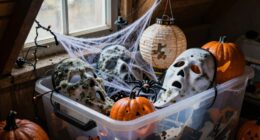You celebrate Halloween because it originates from the Celtic festival of Samhain, signifying the end of harvest and start of winter. Ancient beliefs in a blurred line between the living and dead influenced the traditions. Over time, Halloween blended with All Saints Day and evolved into a mix of cultural practices. Today, it's a time for costume parties, trick-or-treating, and community festivities. Halloween reflects cultural heritage, themes of life and death, and offers a way to contemplate mortality. The holiday's modern traditions include pumpkin carving, trick-or-treating, and themed events. It's a celebration rich in history and symbolism that continues to evolve.
Key Takeaways
- Halloween celebrates the Celtic festival of Samhain, marking the end of harvest and thinning boundary between living and dead.
- Fusion of Celtic, Christian, and cultural traditions over time shaped Halloween into a festive celebration.
- Halloween encourages community bonding through costume parties, parades, and themed events.
- Reflection on life and death is central to Halloween, honoring the deceased and contemplating mortality.
- Modern Halloween traditions like pumpkin carving, trick-or-treating, and themed events continue to evolve and engage participants.
Historical Origins of Halloween
The historical origins of Halloween can be traced back to the ancient Celtic festival of Samhain. The ancient Celts celebrated Samhain as a significant event marking the end of the harvest season and the beginning of winter. During this time, the Celts believed that the boundary between the living and the dead was at its thinnest, allowing spirits to cross over into the earthly domain. Samhain was filled with traditions such as bonfires, sacrifices, and rituals to honor the deceased and seek predictions for the future. These religious observances were an integral part of the Celtic culture and contributed to the origins of Halloween customs that we recognize today.
As history progressed, the Christian church incorporated elements of Samhain into All Hallows Eve, which eventually evolved into the modern Halloween holiday. The blending of Celtic traditions, Christian influences, and Roman festivals gave rise to the unique celebration of Halloween that we now enjoy.
Evolution of Halloween Celebrations

As Halloween made its way to the United States in the 19th century through Irish immigrants, its evolution into a widely celebrated holiday began to take shape. The fusion of Celtic traditions with elements of All Saints Day and Samhain contributed to the development of the modern Halloween celebration.
- Irish Immigrants: The influx of Irish immigrants brought their Halloween traditions, enriching the holiday's practices in the U.S.
- Pagan Origins: Halloween's roots can be traced back to the ancient Celtic festival of Samhain, marking the end of the harvest season and the beginning of winter.
- All Saints Day Influence: The Christian feast of All Saints Day likely influenced the timing and themes of Halloween, blending religious and pagan customs.
- Modern Halloween Celebration: Over time, Halloween evolved into a mix of cultural influences, creating the festive and spooky atmosphere we enjoy today.
Community and Festivities

Bringing together communities and fostering a sense of togetherness, Halloween celebrations are marked by festive activities like costume parties, parades, and haunted houses. Neighborhoods often organize trick-or-treating events, where children go door-to-door for candy, creating a bond among residents. Festivities also include pumpkin carving contests, spooky decorations, and themed events that contribute to an inclusive atmosphere where everyone can participate.
Moreover, many cities host Halloween festivals with live music, food vendors, and entertainment, engaging individuals of all ages in the spirit of the holiday. The essence of Halloween encourages creativity and imagination, allowing people to express themselves through elaborate costumes and themed gatherings. These celebrations not only bring joy and fun but also strengthen the sense of community by providing opportunities for individuals to come together, share experiences, and enjoy the festive season in a lively and engaging manner.
Cultural Heritage Reflection

Halloween offers a window into the historical origins of Gaelic traditions, shedding light on the shift from harvest to the darker half of the year.
By comparing modern Halloween practices to ancient rituals, you can gain a deeper understanding of the festival's cultural significance.
Exploring your personal connection to Halloween can reveal the ways in which this celebration reflects your own heritage and traditions.
Historical Origins Analysis
Delving into the historical origins of Halloween reveals a rich tapestry of cultural heritage and traditions that have evolved over centuries. This holiday's roots can be traced back to the Celtic festival of Samhain, a time to mark the end of the harvest season and the beginning of winter when the veil between the living and the dead was believed to be at its thinnest.
Christian efforts to supplant pagan holidays led to the transformation of Samhain into All Hallows Eve, which eventually evolved into the Halloween we're familiar with today.
The customs of honoring saints and praying for the departed on All Saints Day and All Souls Day have influenced the timing and practices associated with Halloween to a great extent.
Halloween represents a fusion of Celtic pagan traditions, Christian observances, and modern commercial influences, highlighting its cultural importance.
The blend of ancient rituals, religious practices, and contemporary commercialization has shaped Halloween into a holiday that resonates with diverse audiences worldwide.
Modern Traditions Comparison
In exploring the modern traditions of Halloween, one finds a dynamic interplay of cultural influences that shape the holiday's significance in contemporary society. Halloween's origins stem from a mix of Celtic, Roman, and Christian influences, blending ancient Gaelic practices with elements of All Saints' Day and All Souls' Day. These traditions reflect a deep connection to cultural heritage and a fascination with the supernatural.
Similar to Halloween, Dia de los Muertos in Mexico showcases unique community celebrations that honor the deceased. Both festivals highlight the importance of heritage and remembrance, emphasizing the cyclical nature of life and death. The cultural significance of Halloween lies in its roots in ancient traditions, emphasizing the interconnectedness of past and present beliefs.
Through modern traditions, Halloween continues to evolve, incorporating diverse cultural elements while maintaining its essence as a time for communal celebration and reflection. This dynamic interplay of influences underscores the enduring relevance of Halloween as a celebration of cultural heritage and the supernatural.
Personal Significance Exploration
Reflecting on your own family customs and beliefs surrounding this festive occasion can offer profound insights into your cultural heritage and traditions. When exploring the personal significance of Halloween, consider the following:
- Family Customs:
Delving into how your family has traditionally celebrated Halloween can reveal unique practices passed down through generations.
- Beliefs:
Understanding the beliefs and superstitions associated with Halloween in your family can provide a deeper connection to the holiday's meaning.
- Identity:
Exploring how Halloween fits into your cultural identity can lead to a greater sense of self-awareness and belonging.
- Historical Origins:
Investigating the historical roots of Halloween can shed light on why certain customs and traditions are significant to you personally.
Themes of Life and Death

Halloween's themes of life and death represent the natural cycle of existence, reflecting on mortality and cultural perspectives on the afterlife.
The holiday's traditions such as honoring deceased loved ones and acknowledging the spiritual domain highlight the interconnectedness between the living and the departed.
Through costumes, decorations, and rituals, Halloween serves as a poignant reminder of the fragility and beauty of life.
Symbolism of Mortality
Amidst the festivities of Halloween, one can't escape the profound symbolism of mortality woven into the very fabric of the celebration. The themes of mortality, the afterlife, and the cycle of life and death are intricately entwined in the essence of Halloween. Here are some key points to ponder:
- Costumes and decorations reflect the ephemeral nature of existence, emphasizing the cycle of life, death, and rebirth.
- Traditional Halloween colors of black and orange symbolize death and harvest, underlining the interconnectedness of life and death.
- Symbols like skulls, skeletons, and ghosts serve as reminders of mortality, prompting contemplation on the fleeting nature of life.
- Celebrating Halloween allows individuals to confront the concept of mortality, honoring the deceased while reflecting on the profound cycle of life.
Through these symbols and traditions, Halloween provides a unique opportunity to acknowledge and embrace the transient nature of life, inviting contemplation on mortality and the afterlife.
Cultural Views on Death
Cultural perspectives on death heavily influence the way Halloween themes of life and death are interpreted and celebrated. The origins of Halloween trace back to the Celtic people and their festival of Samhain, a time when they believed the boundary between the living and the dead was blurred.
This historical connection to death is still evident today in the holiday's focus on costumes, decorations, and rituals that reflect cultural attitudes towards mortality and the afterlife. Halloween provides a unique opportunity to confront the concept of death in a festive and symbolic manner, allowing individuals to contemplate the cycle of life and remember deceased loved ones creatively.
Modern Halloween Traditions

Modern Halloween traditions involve carving pumpkins, trick-or-treating for candy, and donning costumes to ward off evil spirits. In addition to these classic activities, there are other popular ways people celebrate Halloween in the modern era:
- The practice of bobbing for apples and visiting haunted houses are popular activities during Halloween.
- Halloween parties, decorations, and themed events are common ways to celebrate the holiday.
- Dressing up in costumes has become a significant part of the modern Halloween celebration.
- Many communities organize trunk-or-treat events as a safe alternative to traditional trick-or-treating.
These traditions have evolved over time, blending historical customs with contemporary practices to create a festive atmosphere during the Halloween season. Whether you're exploring a haunted house, attending a themed party, or going door-to-door for treats, modern Halloween traditions offer a mix of spooky fun and community engagement for people of all ages to enjoy.
Frequently Asked Questions
What Is the Real Reason We Celebrate Halloween?
When you wonder about the real reason behind celebrating Halloween, it's important to understand its ancient roots.
Halloween originated from the Celtic festival of Samhain, a time marking the end of the harvest season and the beginning of winter. This holiday allowed for communication with spirits and predictions of the future due to the thinning veil between the living and the dead.
Over time, Halloween evolved with Christian influences to become the holiday as it's recognized today.
What Is the Real Truth About Halloween?
The real truth about Halloween is like unraveling a mystery – a blend of ancient Celtic traditions, Christian influences, and modern commercialization.
This holiday, with its origins in Samhain, signifies the shift from harvest to winter and the thinning veil between the living and the dead.
Over time, Halloween has transformed with costumes, pumpkin carving, and trick-or-treating, becoming a global phenomenon with diverse customs and names.
What Is the History of the All Hallows Eve?
All Hallows Eve, the precursor to Halloween, has a rich history rooted in both Christian and Celtic traditions. Originally a Christian feast day honoring saints and martyrs, it later incorporated elements of the Celtic festival of Samhain.
The term 'Halloween' stems from Scottish words meaning 'saint evening'. Over time, these combined traditions led to the modern-day celebration of Halloween on October 31st, blending religious and pagan customs into a unique cultural event.
Where Did Trick-Or-Treating Originate?
Trick-or-treating originated as a Celtic practice during the festival of Samhain to appease spirits. People would leave out food for them.
In Scotland, the tradition of guising involved dressing up and performing tricks for treats, which influenced modern trick-or-treating.
The term 'trick-or-treat' gained popularity in the U.S. in the 1930s to deter Halloween pranks.
German and Irish immigrants brought 'belsnickeling' to America, where people dressed up and went door-to-door for treats.
Conclusion
So, next time you put on your costume and carve that pumpkin, remember the rich history and cultural significance behind Halloween.
From ancient traditions to modern celebrations, this holiday is a vibrant tapestry of community, heritage, and reflection on life and death.
As you join in the festivities, take a moment to appreciate the layers of meaning woven into this spooky and fun-filled holiday.
Happy Halloween!
